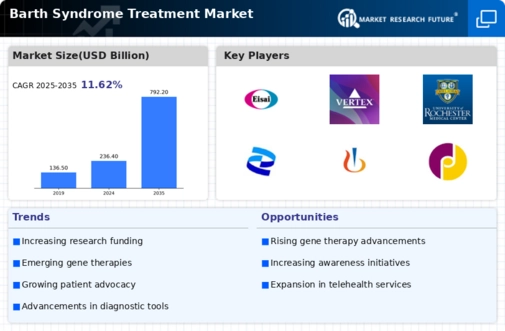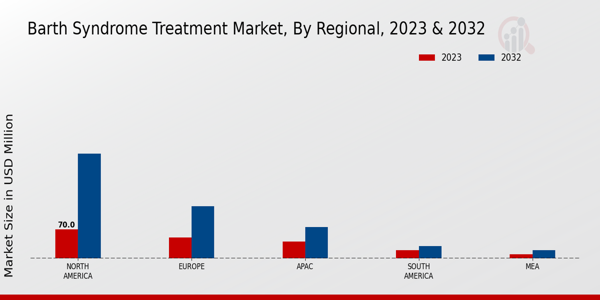Market Growth Projections
The Global Barth Syndrome Treatment Market Industry is projected to experience substantial growth, with a compound annual growth rate (CAGR) of 11.62% anticipated from 2025 to 2035. This growth trajectory reflects the increasing investment in research and development, alongside the rising prevalence of Barth Syndrome. As the market evolves, stakeholders are likely to focus on innovative treatment strategies and patient-centered care, ensuring that advancements in therapy align with the needs of those affected by this rare genetic disorder.
Emerging Therapeutic Options
The emergence of new therapeutic options significantly impacts the Global Barth Syndrome Treatment Market Industry. Innovative treatments, including gene therapy and enzyme replacement therapy, are being explored as potential solutions for managing Barth Syndrome. These advancements may offer hope to patients and families affected by the disorder, addressing unmet medical needs. As the market progresses towards 2035, it is anticipated to reach 792.2 USD Billion, driven by the introduction of these novel therapies and the growing demand for effective treatment solutions.
Growing Awareness and Advocacy
Growing awareness and advocacy for Barth Syndrome play a pivotal role in shaping the Global Barth Syndrome Treatment Market Industry. Patient advocacy groups and healthcare organizations are actively promoting education about the disorder, leading to increased recognition among healthcare professionals and the general public. This heightened awareness can result in earlier diagnosis and treatment, ultimately improving patient outcomes. As advocacy efforts continue to expand, they may also influence policy changes and funding allocations, fostering a more supportive environment for research and treatment development.
Advancements in Genetic Research
Recent advancements in genetic research significantly influence the Global Barth Syndrome Treatment Market Industry. The identification of specific genetic mutations associated with Barth Syndrome has paved the way for targeted therapies and personalized medicine approaches. These innovations not only improve treatment efficacy but also enhance the understanding of the disease's pathophysiology. As the market evolves, the integration of genetic testing into clinical practice may lead to earlier diagnosis and intervention, potentially improving patient quality of life and outcomes.
Rising Prevalence of Barth Syndrome
The increasing incidence of Barth Syndrome globally drives the Global Barth Syndrome Treatment Market Industry. As awareness of this rare genetic disorder grows, more cases are being diagnosed, leading to a heightened demand for effective treatment options. In 2024, the market is projected to reach 236.4 USD Billion, reflecting the urgent need for therapies that address the unique challenges posed by this condition. The rising prevalence is likely to stimulate research and development efforts, fostering innovation in treatment modalities and enhancing patient outcomes.
Increased Funding for Rare Disease Research
The Global Barth Syndrome Treatment Market Industry benefits from increased funding directed towards rare disease research. Governments and non-profit organizations are recognizing the importance of addressing rare genetic disorders, leading to enhanced financial support for research initiatives. This influx of funding facilitates the development of novel therapies and clinical trials, which are crucial for advancing treatment options for Barth Syndrome. The commitment to rare disease research may also attract pharmaceutical companies, further driving market growth and innovation.
























Leave a Comment